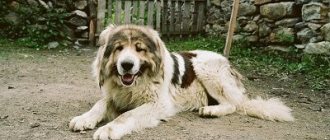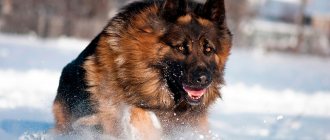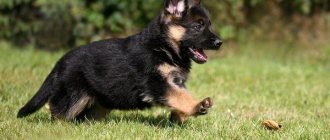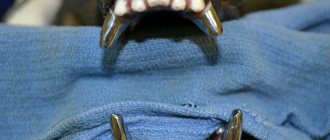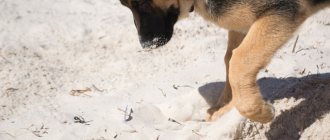Sensitive ears allow you not only to rely on the shepherd as an excellent watchman, but also to guide it from a great distance
A thick-bellied and thick-footed kitten of shepherd color with a long tail and thick fur can only be definitively classified as purebred when the German Shepherd puppy’s ears stand up.
The ears of a real German Shepherd, according to the standard, are erect, of medium size, set high, with the ends directed forward and upward, not adjacent to the skull on both sides, even when the shepherd is in motion, presses his ears or lowers them in a calm state. This “blooming” of the ears is not a fault.
When a German Shepherd's ears stand up when excited, the distance between their highest points (ear tips) should be visually equal to the width of the auricle.
Why does a shepherd dog have such ears?
The deep and voluminous auricle of the German Shepherd is a moving locator that sensitively picks up sound at a frequency of more than 30,000 Hz and at a distance much greater than a person can hear.
Since the range of frequencies a dog can hear is much higher than that of a person, the German Shepherd determines the source of the sound and its direction and distance instantly and accurately thanks to such an auricle at a distance of 25-50 m (depending on the pitch of the sound). And a shepherd dog can detect the sound of thunder or the sound of a running chainsaw at a distance of 9-12 km!
For comparison. The lowest sound for a person is 16 Hz, the highest is 20 thousand Hz. The upper limit of frequency fluctuations perceived by a shepherd dog as sound will be 80-100 thousand Hz.
Delicate hearing is especially important for the German Shepherd, as for a dog with high service qualities and no less high requirements for its work.
Sensitive ears allow you not only to rely on the shepherd as an excellent watchman, but also to guide it from a great distance, giving commands at frequencies that are not perceived by the human ear or in a low voice.
Preventing drooping ears
The pet is less than three months old and its ears can stand up on their own. To make this happen faster, it is recommended to take a number of preventive measures.
- Enrich your baby's diet with minerals and multivitamins. Feed your dog cottage cheese, milk, fish. Sometimes doctors advise pouring crushed and peeled chalk into your pet's food.
- Avoid overfeeding your pet - gluttony will not add health to the dog.
- Clean your dog's ears regularly, treat ear diseases in a timely manner, and avoid injury.
- Monitor your pet's health carefully to avoid complications in the form of pathology in the formation of bones and cartilage.
- Walk with your baby as much as possible and play outdoor games. The more active the puppy, the better the cartilage and bones are formed.
- Create comfortable temperature conditions for your pet to live. Avoid hypothermia.
Massage your baby's ears regularly. Work carefully from the bottom of the ear to the tip. This will improve blood circulation and accelerate the formation of ear cartilage. This massage can be done independently.
"Anatomy" of the ear
All sheep dogs are born blind and deaf - imperfect.
Their small ears are also imperfect - they are soft due to the imperfect cartilage that makes up the auricle. The soft, weak cartilage grows, strengthens and increases in size along with the puppy, turning into an elastic cartilage plate that lacks blood vessels.
The cartilage plate is covered on both sides with a layer of thin connective tissue that provides growth and nutrition to the main cartilage - the perichondrium. The perichondrium, on the contrary, is literally dotted with mini-hematopoietic capillaries and blood vessels, through which the cartilage receives the necessary substances for its growth and compaction using the method of ordinary diffusion (penetration upon contact).
A puppy cannot be confidently classified as a purebred puppy until its ears stand up.
Using the same method, the shepherd's ear cartilage is built up - the perichondrium has semi-stem cells, which, like bricks, are built into the cartilage tissue.
The puppy's ears do not stand up until the perichondrium completes the main cartilage to the required density!
Cartilage cells, in turn, produce collagen and elastin, on which the strength of the shepherd's auricle depends - the density of the cartilage increases due to the addition of new layers on both sides of the perichondrium.
Small German Shepherd puppies have ears that appear too large for their heads. This is due to the active work of all parts of the auricle (cartilage and perichondrium). From 2 to 4 months, active collagen production occurs, the ear actively increases in size, becoming, as it were, “growing.” The scheme of superstructure, increasing the growth and strength of the cartilage works throughout the first period of the puppy’s growth, when its size increases significantly, but the ears still remain drooping.
Puppy ears look disproportionately large
Up to 4 months, cartilage tissues behave especially actively, but by 5 months the growth of elastic layers and the integration of stem cells decreases, and, having reached a certain density, the growth of the ear slows down, so that in a short time it almost disappears.
The metabolism in the auricle becomes so low that visually the ear seems to no longer grow, however, limited living processes in it continue throughout life, otherwise it would be impossible to restore the tissues of the shepherd's ear if damaged.
What is necessary for the proper formation of the cartilage plate and the development of the perichondrium?
First of all, it is necessary to provide the cells of cartilage tissue with nutrition so that they can “build”. To do this, you need to feed the puppy a balanced diet with sufficient amounts of calcium and phosphorus.
Attention! Mineral supplements with a high content of these substances are categorically not recommended for independent use if you want to quickly give your shepherd ears!
Excess calcium and phosphorus can negatively affect the formation of ear cartilage and the development of the musculoskeletal system of the German Shepherd.
We must not forget about the composition of the blood - it is the main nutrition for the growth and strengthening of the cartilage plate, through diffuse contact with it through the perichondrium.
Not only nutrition, but also the obligatory physical activity of a German Shepherd puppy, both at home and on walks, will help improve the blood supply to the perichondrium.
Under such conditions of detention, the shepherd’s ears stand up on time and no additional actions are required on the part of the owner.
If only one ear does not stand up
If only one ear does not stand up, gluing is not practiced. In rare cases, if the doctor determines that the cartilage does not harden due to mobility, the ear (separately) is fixed to a special plastic frame.
Installation of the frame may be accompanied by discomfort, after which the puppy may try to remove it, so he must wear a collar. Usually, instead of a procedure, veterinarians suggest strengthening the diet with minerals. This measure will help if the puppy has normal genetics.
How many months does a German Shepherd's ears stand up and why sometimes this doesn't happen?
The optimal age at which the ears of an OI should stand up is 5 months.
Don't be alarmed if your ears are 1.5-2 months late, it happens.
You should be worried if the puppy is already 8 months old and his ears still do not rise. 10 months is the critical age for ear placement.
If at the age of 12 months the ears are still not on top of the head, you will have to raise the question of the puppy’s purebred.
Growth and appearance of the ears of a German Shepherd from a month to a year
Breed standards
Breed standards do not indicate the time frame within which ears should stand up. However, violation of ear position by the age of one is considered a defect. Depending on heredity, a German Shepherd puppy's ears will finally stand up between 16 and 20 weeks.
After the ears rise, they may fall only because the cartilage has not gained sufficient hardness. This is a common phenomenon that indicates the need to review the diet.
Teeth and ears
It often happens that at 2-3 months the ears of a shepherd dog stand up, and at 4 months they fall off (one or two at once). This is a normal process associated with the change of teeth, when the body mobilizes all the microelements to build a strong dental system, drawing phosphorus and calcium from the cartilage in this direction.
The change of teeth in a German Shepherd is considered complete when real fangs with a wide base appear in the mouth and all molars (molars) erupt - by about 7 months. At the same time, the drooping ears should stand up.
Due to the growth of teeth, the ears of a German Shepherd puppy may fall and rise again.
The growth of molars continues up to 8, maximum 9 months, still drawing calcium and phosphorus into their construction (tooth enamel consists of more than 90% of these inorganic elements), but if, when all the required 42 permanent teeth, the ear cartilage is still not able to lift the ear, you should consult a veterinarian.
Hurry up! After a year, hopes of getting ears for a German Shepherd are fading exponentially.
Reception at the doctor
If you come to see a doctor with the question: “The shepherd’s ears don’t stand up - what should I do?!”, then the doctor, during the examination, will ask you a number of questions:
Did the puppy have any acquired or birth injuries to the ears?
For example, a birth chamber, subluxation or hematoma due to injury to the ear canal.
Have you ever had otitis media or other ear diseases?
For example, inflammation of the middle ear, otodectosis or a forest tick attack.
Have you noticed any allergic reactions in your pet?
For example, for fermented milk products or antibiotics.
If antibiotics or immunomodulators were used, what did you suffer from and how often?
Infectious diseases significantly inhibit the development of a shepherd dog, slow down growth and physiological formation, including cartilage tissue, which determines whether a shepherd puppy’s ears will stand up or whether he will remain lop-eared.
In what conditions is the young “German” kept?
When living in an enclosure, it is necessary to have an insulated booth in the winter (to avoid hypothermia of the ears, leading to spasms of the small vessels of the perichondrium) and a dense canopy from the sun in the summer - overheating also leads to spasms.
Do they walk and communicate with him enough?
A sedentary lifestyle, lack of physical and emotional activity can be a good reason why your dog’s ears are not working.
What bio-feeds did you use during the puppy’s growth period?
For each age of puppies, their own supplements have been developed, and they are divided according to the size of the dog: for small, medium and large dogs.
The German Shepherd is a large breed!
Do either of the puppy's parents have hormonal imbalances?
This is one of the most common problems in purebred dogs, including German shepherds. Diseases associated with an imbalance of hormones lead to problems with the immune system, preventing the body from properly forming all organs and their functions. This is where difficulties arise when a German Shepherd puppy's ears stand up.
Do you keep track of the age-height-weight ratio?
Overfeeding a German Shepherd (as well as underfeeding) leads to a deficiency of micro- and macroelements, which in no way contributes to the timely formation of cartilage tissue by the age when the shepherd should raise its ears.
Have there been any stressful situations?
Cortisol, a stress hormone, activates a “protection mechanism” that blocks the production of new cells (including semi-stem cells in cartilage tissues), reduces blood flow, and forms a negative calcium balance in the shepherd’s body.
Did the puppy's parents have problems with ear placement?
Often this problem is transmitted at the genetic level.
When was your last vaccination given?
After vaccination, the shepherd’s body begins to actively develop immunity. The process requires the consumption of microelements and vitamins for biochemical reactions - their deficiency is formed, as after an illness.
How often do you pet your puppy BUT on the head?
When you touch, the shepherd instinctively folds his ears back, getting used to keeping them curled lengthwise from base to top. The result will be an acquired crease or scar along the entire ear, which will require adjustment of the cartilage.
Don't pet your shepherd's ears!
If the doctor deems it necessary, your pet will have to undergo a blood test, undergo an ultrasound examination and possibly take several x-rays.
Treatment
Based on the examination results, the doctor will prescribe medications (most often flavonoid vitamins, glucosamine, calcitonin, thyroxine, iodine, zinc, iron, manganese, copper and magnesium) that will normalize the blood composition and add the necessary building material to the body.
It is important to carry out drug therapy under the supervision of a veterinarian! An excess of any elements can lead to a deterioration in the general condition of the pet and its ears in particular.
In addition to medications, the doctor will most likely prescribe an ear massage at home. The massage procedure is not complicated - knead the ear from the base to the very tip between the thumb and forefinger, helping to improve blood supply, for about 5 minutes. 3-4 times a day.
Be careful where your ear attaches to your head! There is no need to knead this place, just the auricle itself!
Fingers will get tired - it’s a fact, but a favorable result will not take long to arrive - shepherd dogs’ ears will stand up in just a week or two.
It’s worse if the doctor makes a diagnosis: “Atypical defect of the ear cartilage.” What does it mean? Is it safe for your shepherd's health? And is it possible to give ears to a puppy with such a diagnosis?
Atypical cartilage and ways to eliminate the consequences
Atypical cartilage is a defect in the development of ear cartilage that occurs as a result of a violation of the structure of the ear tissue and its inability to support the ear in an upright position. Insufficiently strong, loose and heavy fibers of cartilage break due to the heterogeneity of the tissue (somewhere dense and flexible tissue, and somewhere soft and “liquid”), and a crease or scar forms on the ear, at the junction.
This often occurs in young dogs after the ears have stood up, and then the German Shepherd puppy has lost an ear or even two.
Puppies' ears stand up between 5 and 8 months of age.
The same picture can be observed in old shepherd dogs - an ear or both then fall, then rise again. The reason is the same: deformation of the ear cartilage due to long years of life - old age.
But the old BUT will no longer be able to return the ears to a stable, standing position. But it is quite possible to correct the position of the ears of a young German Shepherd - they need to be glued, allowing the cartilage to recover.
The gluing is nothing more than the necessary support for the intensive synthesis of elastin (connective protein in tissues) and its uniform growth over the entire area of the ear cartilage.
Properly glued ears prevent creases, stretch the scar and make it possible to fill it with full elastin within 1.5-2 months.
In this case, the puppy or young BUT must be given supporting vitamin supplements containing gelatin. Good results will be given by steep bone jellied meat or soaked food gelatin, 1 tbsp. l. before each feeding.
Adding bone meal and sea fish to your diet is a good solution!
What should you do if your ear gets up and then falls down again?
It happens that the ears
The puppy
gets up
, and after a while
they fall again
. So why does my German Shepherd puppy's ear fall off?
Cynologists associate this feature, which begins at 3-4 months.
During this period it is necessary
:
- include meat and bone meal, milk, fish, jellied meat, boiled pig ears and other products to strengthen cartilage in the puppy’s diet;
- provide the dog with sufficient physical activity;
- regularly attract her attention with unusual sounds, thereby forcing her ears to be fixed in a raised position.
In healthy puppies, after a complete change of teeth, the ears rise again
.
Important!
If this has not happened by 6-7 months,
you need to
show the dog to the veterinarian.
What to do if your ears don't stand up?
If your German Shepherd's ears do not rise
by 7-8 months, then, most likely, they
will no longer get up
.
In this case, a surgical operation can be performed
to insert implants into the shell. Surgery will not eliminate the problem, but it will bring the dog into compliance with existing standards and allow him to participate in exhibitions.
Puppy (5 months) ears drooping
: photo
We glue our ears correctly!
How long should I start the gluing procedure? Until 8-10 months, cartilage correction is unlikely to be needed; most likely, support in the form of massage and, possibly, gartering of two ears together from 3-4 months of age so that they take the correct position on the head.
Details in the video: “How to properly position the ears of a German Shepherd puppy.”
How to determine whether correction is needed?
Feel your ear from base to tip. If you find a thinned area or “liquid” tissue, then look to see if there is a convex scar in this place, along the length of which the ear folds. If a crease or scar is found, it needs to be glued urgently!
How to do this correctly is well shown in the video “Putting ears on a shepherd dog. 2 ways." In addition to 2 methods of gluing broken ears, the video gives a lot of valuable advice to a novice sheepdog owner.
Prevention of abnormal development
In order for their ears to stand up on time, dogs need to be provided with a complete, balanced diet. Calcium (dairy products) and phosphorus (fish) are especially important in this matter. If there is a lack of calcium, the veterinarian may prescribe edible chalk, but you should not overuse it either - this can lead to orthopedic problems in the future. Difficulties with ears can also arise due to excess weight.
Similar article: What vaccinations are required for a German Shepherd dog?
The development of cartilage tissue is directly related to the overall health of the puppy. Moderate physical activity, walks and active games are important. It is necessary to promptly treat any diseases, provide the baby with all vaccinations in a timely manner, and, if necessary, drive away worms. The puppy must live in a warm place: cartilage tissue does not form well at low temperatures.
To ensure that the auricle is positioned correctly, it is recommended to periodically massage it with your fingertips from base to top.
The puppy's ears should be clean and free of dirt and wax. Make sure that they are not pulled by other animals or children.
Developed jaw muscles ensure good positioning of the ear, so the puppy should have special chewing toys.
Gluing ears on a shepherd
If there is weakness of the cartilage tissue in the auricle, they resort to gluing measures. Try to identify the weak part in the cartilage that can be felt with your fingers. If the weak point is located at the tip of the ear, it does not need correction; it will soon stand up on its own. It is preferable to apply the adhesive with a breathable hypoallergenic plaster. The product will ensure the normal condition of your pet's skin and protect against rotting and irritation.
First, you need to cut off the wool from the shell. Then gently wipe your pet's ear from dirt and wax. It is acceptable to use hydrogen peroxide, alcohol or wet wipes.
Two long strips of adhesive are cut to fit the pet's ears. The tapes are glued to each other. The strips are glued to the inside of the ear along the entire length. The puppy's ear is curled into a tube with a hollow inner part. A strip of tape is wrapped around the base of the ear. The bandage is left for 10-12 days. Then the patch must be carefully removed. Do not use tape or tape for wrapping. You can use a popsicle stick to secure the ears. Both ears should be wrapped at the same time, even if one is already fully straightened.




